 |
Generational Differences - Managing The Complexity |
1.00 |
Could dealing with people get any more difficult? Today’s business environment brings many challenges with four different generations working together for the first time. Communication, respect, recognition, retention, interaction with others, and work life balance mean something different to each generation. If not understood and managed effectively workplace conflict, poor communication, low morale, and high turnover can occur. Understand and discover the key values and contributions among these four generations. Each generation provides intrinsic value to an organization. You will learn how to capitalize on the strengths of the Traditionalists, the Baby Boomer’s, Generation X, or the Millennial Generation (Gen Y). By implementing effective strategies for communication, recognition, development, retention, and leadership you will uncover the hidden talents of each generation while minimizing the risk of knowledge transfer. You will learn the key generational differences and similarities in each of these areas. Join us as we share with you some of the many generational challenges in today’s work environment. |
 |
Leading with Head and Heart |
2.00 |
Those in leadership positions have a responsibility to both lead and manage.During this course, participants will understand the differences between the leadership and management, and the steps we can take to cultivate both. Participants will explore how leaders create safe, supportive environments by modeling self-awareness, interpersonal skills and growth mindset in how we lead and manage. |
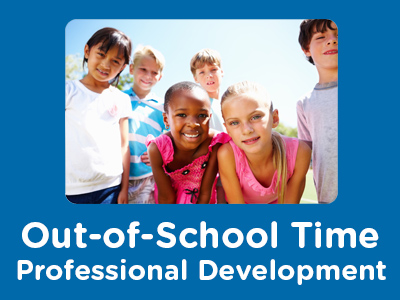 |
Creating Community Collaborations |
2.00 |
Across the country, more and more communities are forming community collaborations to address the out-of-school needs of children and youth of all ages. When different segments of the community join together, share ideas, and pool their resources and efforts to create out-of-school time initiatives, children and youth benefit. What one organization or program may not be able to accomplish alone is often achievable when partnerships and collaborations among diverse groups and individuals are formed.
When school-age care professionals are knowledgeable about what it takes to create and sustain successful collaborations, they can play an important leadership role in creating out-of-school time initiatives and programs that will meet the needs of children and youth in their communities now and in the future. |
 |
Animal Show Development |
1.00 |
This program will provide information about how best to present animals to your guests. We will discuss different types of programs including informal animal encounters, a free flight bird show, a cheetah run program and a mixed species show, including sea lions. For each type of program, we will discuss staffing, collection planning and production, such as sound and props. We will also talk about scripting in general and especially responsible messaging. |
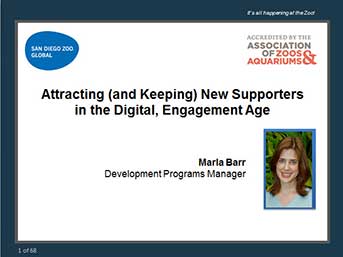 |
Attracting (and Keeping) New Supporters in the Digital, Engagement Age |
1.00 |
There are more non-profits in the market every day, but less donors. Is this a recipe for disaster, or an opportunity for us to transform what donor acquisition, retention and stewardship look like in our digital age? Join us during this 60 minute webinar to learn what innovative donor engagement in 2013 looks like by walking through some of the San Diego Zoo Global's recent digital campaign hits and misses to see how you can help your organization rise above this changing donor landscape. |
 |
Connection Planning in Long-Term Care |
1.00 |
This module includes training for staff and providers in the importance of social connection and practical strategies learners can use to promote social connectedness in long-term care. The module explains how to implement Connection Planning, a brief, person-centered behavioral intervention for developing resident care plans that address social connection. Connection Planning includes evidence-informed, practical strategies to promote meaningful social connection among residents in long-term care. |
 |
Effective Communication with Children and Youth |
2.00 |
We are constantly communicating with the children and youth in our program through our words and actions. It's important for program staff to think critically about their communication skills and habits in order to communicate effectively. During this course, participants will learn about effective and dynamic communication tools, strategies to check for understanding, and activities that engage children and youth in communication. |
 |
California Harassment Prevention Training for Team Members |
1.00 |
Harassment cases have resulted in organizations being liable for hundreds of millions of dollars in legal fees and lost revenue annually. The information presented here enables employees in the organization to create a harassment-free culture. |
 |
Egress, Fire Prevention, & Fire Protection |
0.65 |
In this course, participants will learn about escape routes and exits, emergency action plans, fire prevention plans, fires, fire extinguishers, and workplace fire prevention tips. |
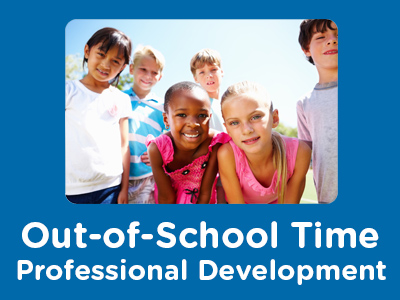 |
Providing Homework Support: Types of Homework Support |
1.00 |
Research indicates there are many different ways to provide effective homework support in school-age programs. When planning a homework support program, it is important for school-age programs to develop a homework philosophy that is consistent with the program’s overall philosophy, and reflects current research on best practices for providing homework help. The homework philosophy should also reflect the needs of parents and children in the program, and strike a balance between homework needs and other experiences that help children grow and learn out-of-school. In this course, we will explore the various types of homework support. |
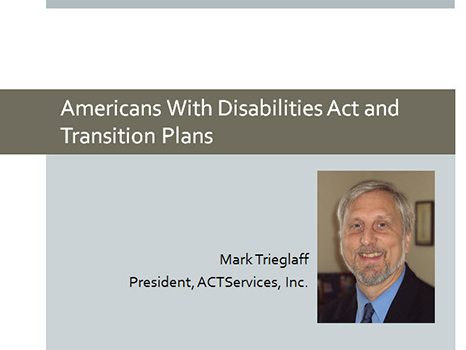 |
Americans With Disabilities Act and Transition Plans |
1.00 |
Do Title II and Title III of the Americans with Disabilities Act apply to you?
Do you work for a non-profit or for-profit zoo, aquarium, or museum? Is your zoo, aquarium, or museum operated by your state or local government? Do you have a Transition Plan or Barrier Removal Plan for your organization? Do you know that the Justice Department or your State's Attorney's Office could sue your organization if you are not in compliance? Fines can cost an organization $55,000 plus compensation just for an initial infraction.
This comprehensive webinar will discuss the development of a plan, examples of that plan, common accessibility issues, and an overview of what to look for in your policies and procedures that could cause an accessibility issue. |
 |
Safety Communication and Training Techniques |
1.50 |
This course covers certain safety and logistics measures for the workplace. This includes topics like different types of safety training, creating safety programs with different learners in mind, and how to use various types of media to communicate objectives. |
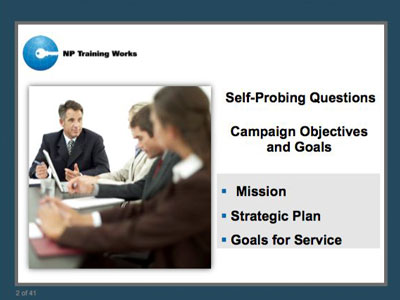 |
Art of the Capital Campaign |
1.00 |
As you learn how to plan, operate and conduct a capital campaign you can find a lot of advice on the science of fundraising. Often, however, your success will depend more on the Art of the Practitioner (you) than the rules of the game. This Webinar is designed to help you become a capital campaign artist by giving you a roadmap to travel from pre-campaign, feasibility, planning, infrastructure, phases and post-campaign wrap-up. You’ll learn the pitfalls to avoid and important tasks to accomplish to become a capital campaign impresario. You’ll learn the tools to help you enjoy the ride. |
 |
Coaching: Communication |
1.00 |
Language is an important coaching tool. The use of suitable words during coaching will help you create relationships, repair employee confidence, and establish plans for employee success. As a coach, you must select words that directly influence your employees’ attitude, behavior, and performance. The use of appropriate language during your coaching sessions will help you convey your messages in a clear and encouraging manner.
In this course you will learn to: clearly express your message by using appropriate language, identify and use nonverbal methods of communication, and receive the desired information by asking effective questions. |
 |
ROAR: How to Build a Resilient Organization the World-Famous San Diego Zoo Way |
0.75 |
Roar: How to Build a Resilient Organization the World-Famous San Diego Zoo Way shows leaders at any level how to unleash the full potential of their teams to create lasting organizational resiliency rivaling that of the world-famous San Diego Zoo. It will show how the Zoo’s operating organization, San Diego Zoo Global, has utilized a set of innovative programs to create its team of exceptional leaders and engaged employees who have engendered its amazing accomplishments.
Featuring real-world stories, best practices, and specific strategies based on 100 years of exceptional leadership, this unique and valuable resource will help organizations of any size and focus to master winds of change, overcome stress and adversity, thrive in times of chaos, and constant in pursuit of their vision, and accomplish extraordinary things. |
 |
GED: Social Studies - Unit 5: Post-Test |
0.25 |
Welcome to Unit 5: Post-Test. This post-test covers civics and government, US history, economics, and world geography. At the end of this post-test is a table that matches each test question to the content it covers. Use it to review and content you haven't mastered. |
 |
Hazard Communication Basic |
1.00 |
This course covers the basics when it comes to hazard communication. The topics will range from the Hazard Communication Standard to the labeling of hazardous materials. |
 |
GED: Reasoning Through Language Arts - Unit 7: The Extended Response |
1.00 |
Welcome to Unit 7: The Extended Response. The last part of the RLA section is the Extended Response, or essay. Here's how it works. You'll be given something to read - a source text or texts - and asked to write an essay in response to a prompt related to the reading. In this unit, we'll learn about two types of essays and take a look at an example of each one. |
 |
Becoming Tech Savvy |
1.50 |
This course was designed to help you learn various tips and tricks to use your devices as efficiently as possible. This includes tech skills, safety & security information, and keyboard and mouse shortcuts. |
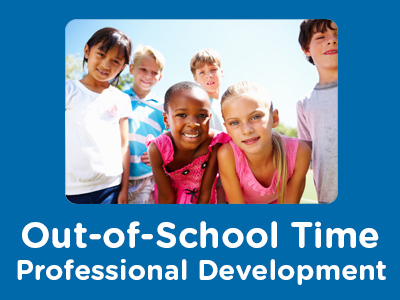 |
Developing Effective Outdoor Environments and Interest Areas: Assessing Space and Planning Activities |
1.00 |
School-age children need daily opportunities to exercise, relax, and participate in a wide range of outdoor activities. The hours children spend in after school programs are often the best hours of the day for getting fresh air and enjoying the outdoors while it's still daylight. School-age programs can provide safe, secure settings where children can enjoy the outdoors. In this course, we will explore how to assess space and plan activities in outdoor environment and interest areas. |
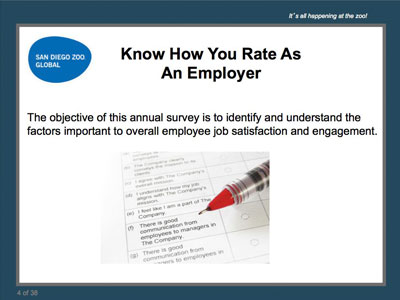 |
Effectively Managing an Employee Engagement and Satisfaction Survey |
1.00 |
There is much scientific evidence that clearly shows a direct correlation between employee engagement/satisfaction and organizational performance. Engaged employees are more productive, profitable and customer service oriented. Engaged employees drive company innovation and have increased tenure. Learn how to conduct a World Famous Employee Satisfaction Survey, and incorporate the right questions to ask to also measure Employee Engagement - which will definitely benefit your organization by showing employees that you have a genuine interest in their feedback. |
 |
Advanced Interpersonal Communication: Organizational Culture |
1.34 |
An organizational culture is the personality of an organization. This personality is both determined and accepted by the organization’s members. For example, an organization might have a culture that is youthful, energetic, and fast-paced. In this type of culture, decisions are made quickly, and employees are empowered to take action in a wide variety of situations. Another organization might be more straight-laced and policy-oriented. This organization would be much more formal and serious in the way it does business. It is important to recognize and understand the culture of an organization, so that you can determine your fit with the organization.
In this course you will learn: to determine the nature of an organization’s culture, to use the cultural network to your advantage, and identify the characteristics of the roles exhibited in the network, to identify the elements of physical culture that affect interpersonal communication, and to identify the ways in which managers can build a positive culture. |
 |
Reducing Foodborne Illness Risk Factors in Food Service and Retail Establishments |
0.50 |
This course covers different risk factors that are insufficiently controlled in institutions, retail food, and restaurants. Recommendations to help these places control these risk factors are also given. |
 |
Combating Sexual Harassment in the Workplace (NY) |
1.00 |
In recent years, the topic of sexual harassment in the workplace has been brought into the national spotlight, bringing with it renewed awareness about the serious and unacceptable nature of these actions and the severe consequences that follow.
Under state law effective October 2018, every employer in New York is required to establish a sexual harassment prevention policy which includes annual training, pursuant to Section 201-G of the Labor Law.
This course was created by CypherWorx based on the 2023 update of the training materials developed by the New York State Department of Labor and Division of Human Rights, and is designed to meet or exceed standards required by state law. |
 |
School-Age Care as a Family Service: Emphasis on Planning Opportunities for Family Involvement |
2.00 |
The foundation for getting parents involved in school-age programs is to keep parents well informed about what is happening in the program. Quality programs also provide parents with opportunities to make suggestions and give feedback on program services through suggestion boxes, feedback forms, and surveys. When parents are encouraged to have input in the program, they develop trust and confidence in the program, and feel a sense of pride and ownership. They are more likely to participate as resourceful partners with program staff when they know their ideas are welcome and valued. Finally, because parents are all different from each other, it's important to provide many different opportunities for them to connect with the program. Staff in quality school-age programs recognize that all parents don't have to be involved in the same way. |


























